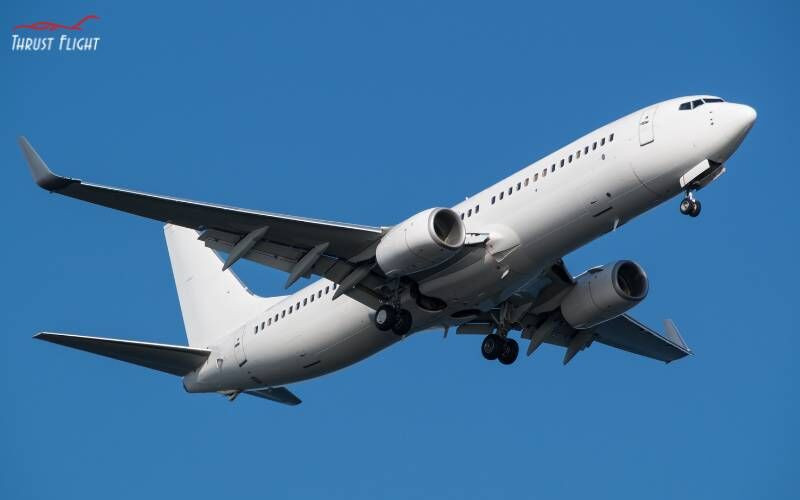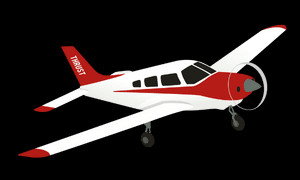The average cruising speed of a commercial passenger plane on a long-haul flight typically ranges from about 880 to 926 kilometers per hour (km/h). In nautical terms, this is approximately 475 to 500 knots, and in miles per hour (mph), it’s about 547 to 575 mph.
However, the speed at which passenger planes fly isn’t a fixed number. Many factors come into play that determine the actual speed of a commercial aircraft. Before diving into these influencing factors, let’s look at the typical cruising speeds of various common commercial airplanes.
Cruising Speeds of Common Commercial Airplanes
Below is a table detailing the cruising speeds for a range of popular commercial aircraft. The speeds are provided in Cruise Mach number, knots (kts), and miles per hour (mph) for easy comparison.
| Aircraft Type | Cruise Mach | Knots | MPH |
|---|---|---|---|
| Boeing 737 MAX | Mach 0.79 | 453 kts | 521 mph |
| Airbus A320neo | Mach 0.78 | 450 kts | 518 mph |
| Boeing 747-8 | Mach 0.855 | 490 kts | 564 mph |
| Boeing 787 Dreamliner | Mach 0.85 | 488 kts | 562 mph |
| Airbus A380 | Mach 0.85 | 488 kts | 562 mph |
| Embraer EMB-145 | Mach 0.78 | 450 kts | 518 mph |
| Concorde SST (Retired) | Mach 1.75 | 1,165 kts | 1,341 mph |
Factors Influencing Airplane Speed
Understanding airplane speed can be complex because aircraft operate within the atmosphere, which is constantly moving. While we might think of speed in simple terms like miles per hour when driving a car, pilots and aircraft engineers consider several different speed measurements.
For airline operations and passenger travel times, the most relevant speed is the ground speed. This is the speed of the aircraft relative to the ground, essentially how quickly the plane is moving from one point on the map to another. Ground speed is directly affected by wind conditions; a tailwind will increase ground speed, while a headwind will decrease it. Think of it like walking on a moving walkway at an airport – your speed relative to the walkway is different from your speed relative to the ground.
However, from a pilot’s and aircraft’s perspective, airspeed is crucial. Airspeed is the speed of the aircraft relative to the air it is moving through. This measurement is vital because it determines the aerodynamic forces acting on the plane, such as lift over the wings. There are different types of airspeed measurements, with True Airspeed (TAS) being the most accurate for performance calculations as it accounts for variations in air temperature and density at different altitudes and weather conditions. Aircraft instruments often display Indicated Airspeed (IAS), which is a direct instrument reading and requires corrections to obtain TAS.
Measuring Airplane Speed: Knots and Mach
In aviation, distances are measured in nautical miles (NM), which differ from statute miles used on land. One nautical mile is approximately 1.15 statute miles. Speed in aviation is commonly expressed in knots, where one knot is one nautical mile per hour. Therefore, when you hear aircraft speeds quoted in knots, it’s a specific unit used in aviation and maritime contexts.
Jet aircraft have design limitations that dictate both minimum and maximum speeds. Most commercial airplanes are designed to fly at subsonic speeds, meaning slower than the speed of sound (Mach 1). Exceeding Mach 1 can lead to the formation of shockwaves on the wings, which can drastically affect the aircraft’s control and stability.
The Maximum Mach Number (Mmo) is the highest Mach number an aircraft is designed to safely operate at. As an aircraft approaches the speed of sound, airflow around different parts of the plane accelerates. Even if the aircraft’s overall speed is below Mach 1, airflow over the wings or fuselage can reach supersonic speeds, creating shockwaves. To help pilots avoid exceeding Mmo, aircraft are equipped with a machmeter, which displays the aircraft’s speed as a Mach number, simplifying speed management at high altitudes. When a commercial airplane is at its cruising altitude, it’s typically flying at a designed Mach number that is well within safe operational limits.
Aircraft speeds might be communicated in knots for lower speeds and during phases like takeoff and landing, and in Mach numbers at higher cruising altitudes where the relationship to the speed of sound becomes more relevant.
Speed Variations During Different Flight Phases
Passenger planes don’t maintain a constant speed throughout a flight. Speed varies significantly depending on the phase of flight. For safety and efficiency, aircraft adhere to specific speed limits and flight profiles.
One key speed restriction is in place at lower altitudes. Below 10,000 feet above sea level, all aircraft are restricted to a maximum speed of 250 knots (approximately 288 mph). Furthermore, in the vicinity of busy airports, this speed limit is often reduced to 200 knots (approximately 230 mph) or less to ensure safe separation and efficient air traffic management.
Beyond these restrictions, each flight phase—climb, cruise, and descent—has its own optimal speed profile designed for efficiency and safety.
Climb Speeds
During takeoff and initial climb, the immediate priority is to gain altitude quickly. Climbing to a safe altitude is crucial as it provides pilots with more options in case of emergencies, such as engine failure. Initially, pilots aim for the best rate of climb, which maximizes vertical ascent in the shortest amount of time. This involves flying at a relatively slower forward speed to achieve a steeper climb angle.
Once the aircraft reaches a safe altitude, the climb profile transitions to a more efficient one. This typically involves reducing engine power and lowering the nose slightly to increase forward speed while maintaining a slower, but still effective, climb rate. This trade-off prioritizes fuel efficiency and a smoother climb experience for passengers.
 Commercial airplane flying at takeoff speed
Commercial airplane flying at takeoff speed
Cruise Speed
The cruise phase is the longest part of most flights, and it’s conducted using a pre-determined flight profile optimized for efficiency. Pilots set engine power and fuel consumption rates based on the flight plan, and the resulting airspeed and Mach number dictate the ground speed and overall range of the aircraft.
As seen in the cruising speed table, most airliners have remarkably similar cruise performance. The limitation around Mach 0.85 is typical for subsonic commercial aircraft. This is because, even at this speed, air accelerating over parts of the aircraft is approaching the speed of sound. To fly significantly faster subsonically would require substantial design changes and wouldn’t be as fuel-efficient as staying within this speed range.
The thinner air at higher altitudes allows jet engines to operate more efficiently. However, it also means the wings need to generate lift in less dense air. To achieve this, the aircraft must fly at a higher speed to ensure sufficient airflow over the wings to prevent stalling. This creates a narrow speed window for airliners at cruise altitude: fast enough to avoid stalling, but slow enough to remain below the Maximum Mach Number. This balance results in many modern airliners cruising at roughly similar speeds.
During cruise, aircraft may need to adjust their speed when encountering turbulence to ensure passenger comfort and structural safety.
Descent Speeds
During descent, commercial planes undertake two main types of speed management: cruise descent and approach for landing. Cruise descent involves gradually losing altitude without excessively increasing forward speed, which could lead to exceeding the Mmo. This is typically achieved by reducing engine thrust and allowing gravity to assist in the descent, with minimal change to forward speed initially.
As the aircraft descends below 10,000 feet, the 250-knot speed restriction becomes mandatory. To slow down, pilots reduce power further and may deploy drag-inducing devices like air spoilers. Reducing speed also reduces airflow over the wings, so pilots use flaps to increase wing lift at lower speeds, maintaining control and preventing stalls.
During the final approach to the airport, the aircraft slows down considerably for landing. Approach speeds are typically around 150 knots or less. This phase requires maximum use of wing flaps and other high-lift devices to maintain lift and control at these reduced speeds, ensuring a safe landing.
The Realm of Supersonic Air Travel
When considering how fast passenger planes can fly, the Concorde immediately comes to mind. This iconic aircraft was the only supersonic airliner to operate commercially, flying from 1976 to 2003 for Air France and British Airways. The Concorde remains a significant example when discussing airplane speed and performance, highlighting both the possibilities and challenges of supersonic flight.
The Concorde achieved record-breaking speeds and accumulated more supersonic flight hours than any other aircraft. Notably, in 1996, a British Airways Concorde flew from New York to London in just 2 hours and 52 minutes, aided by a strong tailwind. The Concorde also set round-the-world records in 1992 and 1995, showcasing its incredible speed capabilities, although these journeys included multiple refueling stops.
Despite its technological marvel and prestige, only 20 Concordes were ever built, and supersonic commercial travel never became mainstream. Key factors limiting its success included extremely high fuel consumption and operational costs. Furthermore, the loud sonic booms generated by supersonic flight restricted its supersonic routes to over-ocean flights, making transcontinental supersonic travel over land impractical due to noise regulations.
However, advancements in technology are rekindling interest in supersonic flight. Several startups are now developing new supersonic transport (SST) designs, aiming to overcome the limitations of the Concorde. These new projects leverage modern design techniques and materials to reduce sonic boom impact and improve fuel efficiency. Boom Supersonic, for instance, is gaining attention with its Overture airliner, which has already received orders from major airlines like United and American Airlines. While still in development, the Overture is projected to cruise at Mach 1.7, potentially cutting flight times significantly, such as London to New York in approximately 3 hours and 30 minutes.
- About the Author
- Latest Posts
Jarrod Roberts
Jarrod Roberts brings a wealth of experience to the Thrust Flight team, with a flying career spanning over 15 years. His journey in aviation began with a BS in Aeronautical Science from Texas A&M Central. After working as a flight instructor, he joined SkyWest as a First Officer and then later upgraded to Captain. He now flies for a legacy airline. Jarrod also serves as the Chief Pilot here at Thrust Flight where he guides our team of flight instructors in delivering top-tier training to our many Zero Time to Airline students.
Become an Airline Pilot, Join the Zero Time to Airline Program
Land your dream job as an airline pilot in as little as 2 years. Get on the path to this incredible, high earning career today. Click the button below to learn more.
 Thrust Flight Piper Archer
Thrust Flight Piper Archer
Learn More
Want to become a more confident pilot?
Subscribe to our YouTube Channel where we post FREE content to help student pilots understand the art of aviation.
Be entertained and educated on our TikTok channel.
Or check out some of our most popular articles on how to become an airline pilot and airline pilot salaries.
Previous: Top 19 Biggest Airplanes in the World
Next: How High do Planes Fly?
